The "Hunting Dogs" is a late added Hevelius constellation. Hevelius added this and other constellations in his sky atlas in 1690. The Hunting Dogs are a popular motif for astronomy photographers, due to its many fairly bright stars, easily recognized by the naked eye.
Shape and position: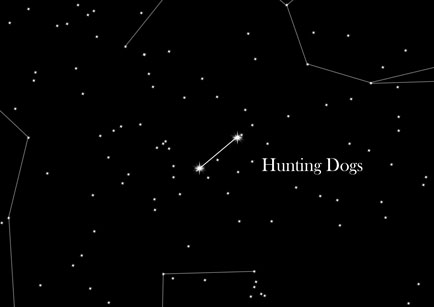
The constellation "Hunting Dogs" is relatively bright and can be seen even by the naked eye on dark nights. This constellation is full of beautiful objects - including a Globular cluster and galaxies with many interesting and binary systems. Many of these objects were already known to Charles Messier, who recorded it in his catalog. Messier discovered the Galaxy M51, a spiral galaxy 30 million light years away.
Right ascension: 12h 14h 6m to 7m
Declination: +27 ° to +52 °
Brightest star: Alpha Canes Venatici
Mythology:
The "Hunting Dogs" is a fairly new constellation. It is a so-called "modern constellation", which was recorded by Johannes Hevelius in his sky atlas. In contrast to so-called "classical constellations of Antiquity", the modern constellations were defined much later and added with no mythology about them.
Best season for observation: Spring
Neighbouring constellations: Great Bear, Berenice's Hair, Herdsman
Buy a Star Blog
-
Star Sign Hunting Dogs
-
Star Sign Bull
The constellation of Taurus is found on both sides of the elliptical orbit of the Sun, thus making it one of the 12 astrological signs of the Zodiac. This constellation is seen in the winter sky, especially around December and January, and is remarkably easy to observe, due to the pronounced nature of many of its beautiful stars.
Shape and position: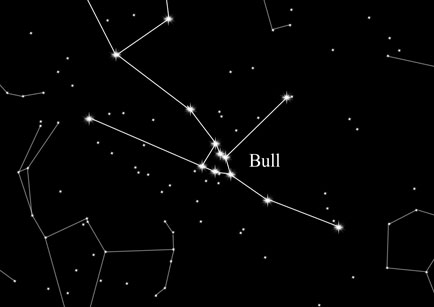
Taurus appears in the sky, in the shape of a bull and can be found northeast of the prominent Orion Nebula. Amongst its most noticeable features are the "v" shaped formations of stars known as the Hyades, which make up the bulls head. The eye of the bull is demarcated by the reddish glow of the Star Aldebaran. The peak of the bull’s horn is represented by the star Elnath, the second brightest star of the bull constellation, which is located in an easterly direction from Hyades. Finally, the relatively young group of stars known as the Pleiades is located near Elnath.
Right ascension: 18h 40m to 20h 35m
Declination: -2 to +31°
Brightest star: Aldebaran
Mythology:
In Greek mythology, the King of the Gods Zeus was besotted by the beautiful Europa. Zeus decided he wanted to seduce Europa, so he poised as a large white bull. While Europa was picking flowers, she came across this impressive bull and sat on his back and started to caress it. She became so preoccupied by this activity that she did not notice him moving. They swam away, finally arriving on the Island of Crete. Once they arrived on Crete, Zeus revealed himself to be the God Zeus, whereupon he made Europa the Queen of Crete. In commemoration of his transformation into a bull, Zeus created Taurus the constellation of the Bull.
Astrological significance: Taureans are ruled by the element of the Earth, which makes them practical people. Taureans, like Zeus the King of the Gods, are strongly passionate and romantic in character. Happiness for Taureans comes in time, by patiently building up a successful life for themselves and their families.
Best season for observation: Winter
Neighbouring constellations: Auriga, Perseus, Ram, Whale, Eridanus, Orion, Twins -
Star Sign Lynx
Although the Lynx is a nondescript, barely visible constellation, not visible from the Earth, it has very bright stars. Exactly 12 billion light years away from Earth region always form new stars.
Shape and position: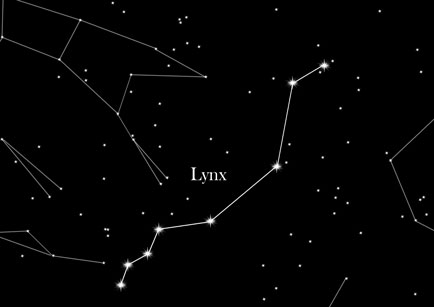
The lynx is found between the constellations "Big Bear" and the "Herdsman" in the northern star sky. It is an inconspicuous but rather big constellation. The Lynx constellation is like a chain of clear and faint stars in a sky area with very other few stars around. Especially you can see the Lynx in dark nights, which can be based on the primary star, at least the size is below magnitude 3.
Right ascension: 6h 16m to 9h 42m
Declination: +32 to +61 degrees
Brightest star: Alpha Lyncis
Mythology:
Since this constellation was not listed by Johannes Hevelius in the sky atlas until 1690, there is no Greek mythology about the Lynx. However, the name Lynx has to do with the fact that It is quite a dark constellation. Its firm boundaries gave it the name Lynx in 1930 by the "International Astronomical Union" (IAU).
Best season for observation: All year round
Neighbouring constellations: Great Bear, Giraffe, Charioteer, Twins, Crab, Lion, Smaller Lion -
Star Sign Smaller Lion
The constellation "Smaller Lion" is not one of the classic, ancient constellations. Therefore, there is no mythological background to this constellation. Naming the constellation happened in 1930 and was a memorable error, which has been preserved until today. When assigning Greek letters to the stars, the astronomer Francis Baily failed to notice that no alpha letter was assigned to "Leo Minor". He provided one of the brighter stars accidentally with the letter beta, which to this day remained the case.
Shape and position: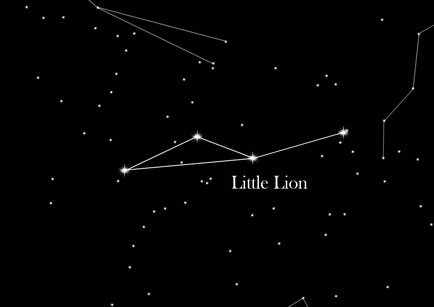
The constellation "Smaller Lion" lies between the constellations "Lion" and "Big Bear" in the northern sky. The constellation "Smaller Lion" have many double stars, such as the 40 Leo Minoris and 11 Leo Minoris. Worth noticing is also "R Leo Minoris" - its brightness varies during the period of 372 days between 6.3 m and 13 m.
Right ascension: 9h 22m to 11h 6m
Declination: +22 ° to +41 °
Brightest star: Praecipua (46 LMi)
Mythology:
Since the "Smaller Lion" was not introduced until 1687 by Johannes Hevelius, this constellation is not of Greek mythology. Hevelius added the constellation "Smaller Lion" to his Sky Atlas in 1690 merely as a small filling pattern. The Gdańsk astronomer named the stars even after Greek letters, and in 1930 it became one of the brightest stars with the Greek letter beta linked to it.
Best season for observation: Spring
Neighbouring constellations: Great Bear, Lion, Crab, Lynx -
Star Sign Aries
Aries is a small constellation with great significance. The bright stars α (Hamal), β (Sheratan) and γ (Mesarthim) represent a curve. The sun enters Aries on the 19th of April and remains there until the 14th of May. Nonetheless Aries can be best observed in autumn.
Shape and position: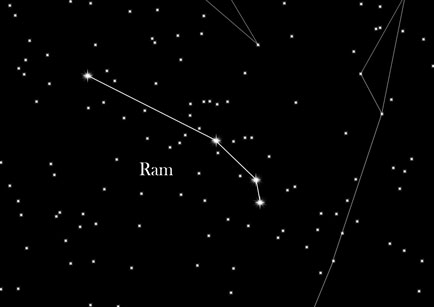
Aries is found to the south of the mousy constellation Trangulum and to the west of Pisces. Aries shows itself as a slightly bent curve, to see an actual ram in the constellation requires a colorful phantasy. Beta Arietis is a double star system. 53 Arietis, another interesting star of the Aries constellation. Barely visible with the naked eye, it astonished astronomers with the exceptional speed with which it travels through space – at more than 160 miles per second.
Right ascension: 01h 46m to 03h 29m
Declination: +10 to +31 degrees
Brightest star: Alpha Arietis (Hamal)
Mythology:
The constellation of Aries was first mentioned in the Mesopotamian culture, more than 5000 years ago. It was known as the Agrarian. The interpretation as a ram has its roots in the tale of the Golden Fleece. A gold-haired, winged ram, sent by the Olympians, saves Prince Phrixus from being sacrified, when he is entangled in a succession dispute. In gratitude Phrixus sacrifies the ram, which afterwards ascents into the skies. His Golden Fleece subsequently becomes a legendary relic. Even after the death of the ram it maintains its central role in Greek mythology, for example in the famous Argonautica.
Astrological meaning: Those born in the sign Aries are said to be passionate and determined. Headfirst through the wall is the credo of the Aries. His honesty and sympathy make him a pleasant man.
Best season for observation: Autumn
Neighbouring constellations: Triangulum, Perseus, Taurus, Cetus, Pisces


